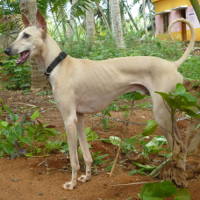Appearance of the Chippiparai
|
| Tall, slender and elegant are words used to describe the Chippiparai, as well as being lean and narrow in body. While some would say this dog looks emaciated, the truth is that the lean, slender body with prominent ribs is the correct appearance for this breed. They have long, narrow limbs with elegant, rounded legs, a thick chest that gives them stamina and a tucked-up belly that gives them that Greyhound or Saluki silhouette. The face and head of Chippiparai are long and narrow, and their ears are either pink or semi-erect. Although the muzzle is long and narrow, a hint of substantial power is visible in these jaws. These dogs have beautiful, forward-looking eyes, giving them an impressive field of vision. Their expression is often gentle but intense and always very lively. The eyes are dark in color, although light-coated dogs may have lighter eyes. The coat is perfect for the sweltering, intense heat of India, being very short and exceptionally smooth. The Chippiparai offers a range of coat colors, the most common being fawn, a red-tinged brown, a gray and a slightly tinged black coat. White markings are often a feature. |
Temperament of the Chippiparai
|
| Chippiparais are renowned for their calm, gentle disposition. Rarely vocal, they don't bark as much as other breeds. And although they have lots of energy and love to work, they don't need big meals to compensate. Chippiparais are a self-reliant breed and can tend to be stubborn. Yet their intelligence and devotion to their owners make them easy to train. They have close bonds with their owner and family, although they can be reserved and aloof with strangers. The breed is ideal as a guard dog due to its highly protective nature. They are kind and gentle with the children in their family, but dislike rough play, disrespectful tail wagging and ear biting. Although you might think they wouldn't mix well with other dogs, the reality is completely the opposite. Socialized at an early age, they can get along very well with other dogs. Smaller pets and even the smallest dogs can be considered prey. So keep your dog on a leash when you walk, and install a very high fence around your garden so your Chippiparai doesn't take off after fast furry objects. These adorable dogs are on the verge of extinction, but with growing interest from local breeders, we can hope they will once again become a popular dog, respected for its qualities and beauty. |
Needs and activities of the Chippiparai
|
| The best way to describe Chippiparais is that they are very active. They have an exceptional hunting instinct, using their visual and scenting abilities, and can survive excessive heat better than any other dog known. Fully adapted to the rigors of the climate, their lean, muscular bodies are designed for running, endurance, and confronting and killing wild and dangerous animals. Although your dog loves to run with you, he also needs time to run freely. Try to find a safe place for them to burn off energy without being able to chase any small animals they might see. They need at least 90 active minutes of exercise every day to stay healthy and keep their dog happy. Because of their high energy levels, they are not a good choice for an apartment. Without enough space and exercise, Chippiparais can become destructive, nervous or hyperactive. |
Maintenance of the Chippiparai
|
| The Chippiparai is easy to care for and maintain thanks to its short, slender coat that rarely seems to shed. As a result, they are a very low-maintenance dog that never needs professional grooming. A simple weekly brushing is all that's needed. Perhaps an occasional bath with a mild dog shampoo will suffice. A routine check of all working dogs for parasites is important - the sooner they are discovered, the better they will be eliminated. An ear check is always part of the grooming program, as are nail checks and trimming if necessary, and the all-important cleaning of your dog's teeth. Keeping on top of these requirements will keep your dog happy and healthy. |







 English (United Kingdom)
English (United Kingdom)